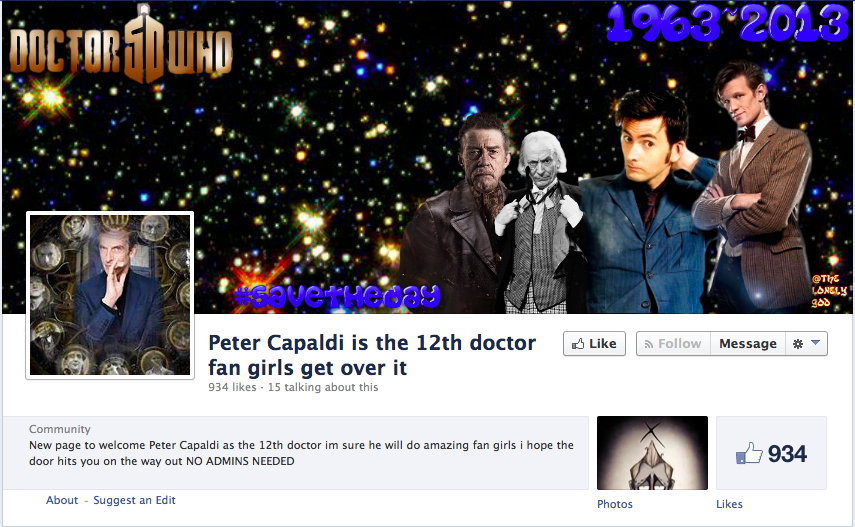The Cultural Lives of Doctor Who: Doctor Whose Fandom?
When Peter Capaldi was unveiled as the new Doctor Who in August, The Daily Mail reported an “ageism row” as fans purportedly dubbed Peter Capaldi “’too old’ to play the Time Lord.” Although The Daily Mail cited negative responses from both male and female viewers and included positive responses from female fans, the negative responses were quickly ascribed in much of the press, and on social media, to “fangirls.” Witness the Facebook page, “Peter Capaldi is the 12th doctor fan girls get over it.” In claiming that fangirls alone were critical of the choice of the new Doctor, people simultaneously dismissed fangirls as lesser fans than male fans or “true” Whovians, and assumed that fangirl interest in the show was exclusively romantic or sexual, that Capaldi was seen negatively because he was not as erotically attractive as recent actors David Tennant, or Matt Smith. This, despite such fangirl reactions as the YouTube video “Peter Capaldi is the new Doctor! (A fangirl’s thoughts on this),” posted immediately after the announcement in which the self-identified fangirl says she is “glad it is not a younger guy. I am tired of these plot lines between the Doctor and his companions and all this… sexual tension.” As L.B. Gale writes in his online essay “In Defense of Doctor Who Fangirls,” “The assumption behind this ‘true Who fans’ conversation is that the ‘true fans’ are the geeky men who were able to get the ‘big ideas about humanity’ behind the show while the fair weather fans were all the little girls who were just pornographically enjoying the series because of how good looking Smith and Tennant are” The dismissal of fangirls is familiar to those of us who study pop culture as a stereotypical denigration of feminized mass culture in opposition to masculine “art.” It assumes that female fans are an add-on, derivative, and lesser than male fandom, which is assumed to be motivated by more serious interests (e.g., the vagaries of time travel vs. the appeal of TV stars).
In opposition, I would like to suggest that fangirls are not one fandom among many, or an add-on to the Whovian empire, but the ur-fans of Doctor Who, the original targeted audience and point of identification within the show. Jill Lepore’s recent New Yorker essay on Doctor Who (“The Man in the Box: Fifty Years of Doctor Who”) makes clear that capturing a female audience was essential to the show’s original plan. When Sydney Newman, then head of BBC drama, decided to produce a science fiction series, he commissioned a report that argued against doing so: the report claimed that sci-fi was not only too American, but also, and more problematically, too unappealing to women. Intending to create a “loyalty program” that people would watch every week, and one that would appeal to women as much as men, Newman decided to “flout the genre’s conventions.” Newman hired Verity Lambert, the only female producer at the BBC, and together they determined that the Doctor should have a female companion to “add feminine interest.” Thus, the companion provides a relay for female viewers, a point of identification within the show.
Given the companions’ penchant for crushing on the Doctor, at least in the recent series (“all that sexual tension” the fangirl YouTube video cites), is it any surprise that young women might identify with Rose, Martha, Donna, Amy, and Clara? All of whom, except perhaps Donna, at one point or another kiss and/or flirt with the Doctor. The companion is a built-in fangirl, one who encounters the Doctor accidentally, but once let into the Tardis (bigger on the inside, like a TV, as Lepore notes) commits to a “loyalty program” of traveling with him, leaving her everyday life behind (even bringing her boyfriend along for the ride in the case of Martha and Amy) – a life that Keara Goin says in her previous Antenna blog in this series is “made to seem secondary, bland, and lacking excitement.”
The importance of the fangirl to the series, and her embeddedness within it, was reaffirmed in the 50th anniversary “The Day of the Doctor.” This episode featured among its characters a young geeky girl, Osgood (Ingrid Oliver), wearing the fourth Doctor’s scarf like a cos-playing fangirl, and enthusing over the Doctor, whose exploits she has studied. In this special episode, former companion Rose Tyler (Billie Piper) plays the Time Lord’s “conscience,” and wittily describes the basic premise of the series when she notes that he is “stuck between a girl and a box – story of your life, eh Doctor?” Here, the Doctor’s conscience reminds us that the fangirl fantasy is not external to the show but stitched into the fabric of the narrative, the essential story of the Doctor.
Nonetheless, while fangirls have been ascribed a certain role within the narrative and as spectators, fangirls have veered from the plot in fascinating ways. Looking around on tumblr, the fangirl epicenter, one finds numerous sites dedicated to Doctor Who. In addition to cute images of Tennant and Smith, or fantasy “ships” (or fan fantasy relationships) of the Doctor and his companion, there were images of Daleks, GIFs that celebrated reading (quoting the Doctor’s claim that books are the “best weapons in the world”), and archival images detailing the history of the show and sorting its timey-wimey logic. There are frequent gay “ships” related to the Tennant’s Doctor and captain Jack Harkness (John Barrowman), auteurist links between Steven Moffat’s Sherlock and his Doctor Who episodes in queer Sherlock “ships” between Sherlock and Watson or Sherlock and the Doctor, or pages that juxtapose fandoms for Harry Potter, Supernatural, The Hobbit, and more. Assuming that fangirl activity is limited to expressions of heterosexual attachment to young actors denies the range and complexity of these responses. It is a misplaced fantasy about the girl’s proper place in the Whovian universe.




